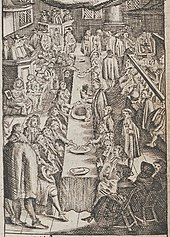Dinner

The evening supper is a form of the communion worship service in which the communion is emphasized.
history
16th Century
During the Reformation there were various attempts to celebrate the Lord's Supper according to the institution of Jesus Christ : simple bowls and drinking vessels made of base materials, the table instead of the altar in the center of the celebration. Even Huldrych Zwingli made in 1525 especially for the celebration of Holy Communion a table set up; however, the parishioners remained in their places, and bread and wine were carried around in wooden bowls and goblets and passed among those communicating. The biblical model was the parable of the great feast .
Johannes a Lasco created an ordinance ( forma ac ratio ) for the reformed refugee community in London in 1550 , in which the concept of the evening meal is consistently implemented:
- In groups, the congregation members sat down at the sacrament table covered with a linen cloth, first the men, then the women.
- The pastor, who was also seated at the table, gave the blessing over bread and wine.
- Pewter bread bowls and glass drinking vessels were passed on by the communicants.
- Congregation elders assisted with the meal by refilling bread and adding wine.
This celebration took place once a year, on the first Sunday in January for the Dutch community and on the first Sunday in February for the French community. The deacons distributed the remains of bread and wine to the poor after the celebration. The peculiarity of a Lasco's Lord's Supper is that the communicants sat according to the biblical model, whereas otherwise they received bread and wine while kneeling or standing at Lutheran, Reformed or Anglican services.
20th century
Already in the General Evangelical Church Hymn book of 1955 there was a simple arrangement of the dinner table "according to the way of the Brethren", which described a domestic celebration based on the model of the early church , with ordinary bread and wine in jugs and cups. A satiation meal ( agape ) can follow.
Further impetus was given today's celebration of the table Supper of liturgical experiments in berneuchen movement ( tabletop exhibition ) and through the celebration of Holy Communion as first quasi experimental, then, at the Church in Nuremberg in 1979 and with the experience gained from this service in the church conference in Hamburg in 1981 celebrated has been.
As the elder of the Evangelical Michael Brotherhood, Karl Bernhard Ritter published in 1961 the agende The Eucharistic Celebration, the Liturgy of the Evangelical Mass and the Sermon Service . It contains an order of the dinner table. The table is festively covered with white linen, candles and flowers (also in a private house), with the liturgy at the head of the table. In front of him are vessels with bread and wine, covered by a velum. On either side of the liturgist are two assistants who also act as prayer leaders. The Evangelical Church of Kurhessen-Waldeck adopted this order in a somewhat simplified form in 1969 in the draft of its church agendas. This marked the step from the liturgy of a brotherhood to the area of a regional church.
Individual evidence
- ^ Peter Opitz : Ulrich Zwingli: Prophet, Heretic, Pioneer of Protestantism . TVZ, Zurich 2015, p. 70.
- ^ Frieder Schulz : The Last Supper as Communio . In: Synaxis: Contributions to the liturgy . Vandenhoeck & Ruprecht, Göttingen 1997, pp. 174–192, here p. 188.
- ↑ Michael Stephen Springer: Restoring Christ's Church: John a Lasco and the Forma Ac Ratio . Ashgate, Burlington 2007, p. 86 f.
- ↑ Michael Stephen Springer: Restoring Christ's Church: John a Lasco and the Forma Ac Ratio . Ashgate, Burlington 2007, p. 86.
- ↑ Michael Stephen Springer: Restoring Christ's Church: John a Lasco and the Forma Ac Ratio . Ashgate, Burlington 2007, p. 88.
- ↑ Guido Fuchs : Ma (h) l different: Eating and drinking in church services and church rooms . Pustet, Regensburg 2014, p. 108.
- ↑ Guido Fuchs: Ma (h) l different: Eating and drinking in church services and church rooms . Pustet, Regensburg 2014, p. 112.
- ↑ Guido Fuchs: Ma (h) l different: Eating and drinking in church services and church rooms . Pustet, Regensburg 2014, p. 128 f.
- ↑ Guido Fuchs: Ma (h) l different: Eating and drinking in church services and church rooms . Pustet, Regensburg 2014, p. 109.
